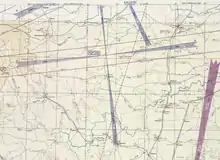Visual Aural Radio Range
The Visual Aural Radio Range (VAR)[1] was a short range radio navigation aid, used from about 1940 until 1960, that provided four-course visual and aural track guidance signals at a range of about 100 miles.[2]
The VAR bridged the technological gap between the Low-Frequency Radio Range (LFR) radio navigation system and the VHF omnidirectional range (VOR) navigation system. VAR provided four courses for navigation, two using visual instrument signals functionally and technically similar to the modern localizer and backbeam components used in the ILS system and two using audio signals similar to the LFR system. VAR also used marker beacons similar to the ILS.
History
In the United States

The Bureau of Air Commerce created a demonstration version of the VAR in 1937 at an Indianapolis research center. A demonstration version of the VAR system was built in 1941 between Chicago and New York.
Initially, war shortages of VHF radio equipment prevented the system from being widely deployed. The first operational installation of a VAR was in Matawan, New Jersey in 1944. By 1948, the Civil Aeronautics Authority had built 68 VAR installations on various federal airways across the United States. Quickly overtaken by the more advanced VOR system, VARs never replaced LFR as the primary airway navigation system of the United States. The last VAR was decommissioned in 1960.[3][4]
References
- "ICAO List of Abbreviations" (PDF). 18 November 2010. Archived from the original (PDF) on 2 April 2015. Retrieved 3 Mar 2015.
- Operational Notes on Visual-Aural Radio Range and Associated Marker Beacons. Commonwealth of Australia Department of Civil Aviation. 1953.
- Nolan, Michael (2010). Fundamentals of Air Traffic Control. Cengage Learning. ISBN 9781435482722.
- "Flight Inspection History". www.faa.gov. Retrieved 2015-12-21.